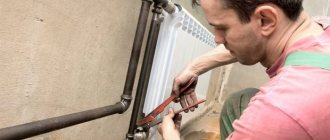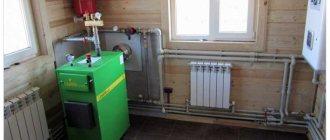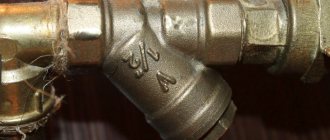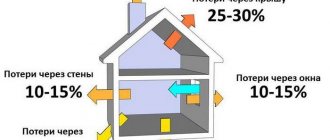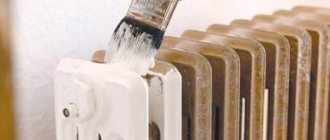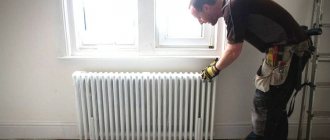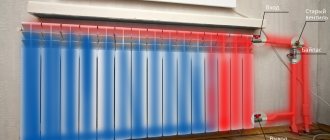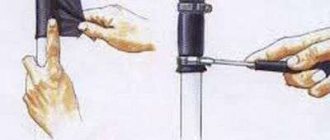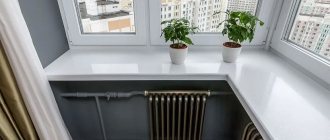There are frequent situations when the problem of a heating battery not heating arises. Sometimes you have to rack your brain in search of the reasons why the situation is happening and how to fix it. We have collected for you 7 possible reasons why radiators may not heat up and offer to study each in detail.
Important! This article is especially relevant when starting heating systems. Many, like you at the moment, may be experiencing difficulties with batteries. Your repost of our material may help someone quickly solve their problem. Don't forget to click on the social buttons. networks at the very bottom of the article!
Bypass
The bypass is the same pipe that stands in front of the installed heating device. Everyone has one, it’s needed to bypass water past the battery. If installed incorrectly - too far from the radiator, or in line with the central riser, it does not allow water, which tends to travel along the shortest path, to circulate normally, heating the radiator sections. In this situation, they will either not heat at all or will be very bad. Check how your bypass is installed. Perhaps this is the direct reason why the batteries do not heat up
Three way valve
Such a tap is required to switch the bypass-battery direction. If this is the reason that the radiator does not heat, then the problem can be eliminated in 3 ways:
- No disassembly. In cases where the tap turns easily, but switching does not occur at all (neither one nor the other works), you can try to develop the device using multiple turning movements. In this case, blockages, as a rule, are washed away by the flow, going into the riser. The operation of shut-off valves is restored in full.
- With partial disassembly. There's no way to turn the tap? We're not trying to break it. Carefully unscrew the locking screw of the handle, remove it, place the screw back in order to prevent deformation of the part during further work. Further actions are carried out with a wrench. It is not recommended to use round nose pliers, pliers, etc. The reason is the same as with the screw - not to damage the rod. Holding the rod with a wrench, we smoothly rock it back and forth, starting with minimal vibrations. If you cannot make minimal movements, slightly loosen the large hex nut that presses the stuffing box seal. If it starts to dig in, place a small container. Continuing the work, moving the rod, press the seal into place, turning the large nut back accordingly. We unscrew the screw, install the handle, screw in the screw, and rejoice.
- In rare cases, when the internal stop is simply torn off, the crane has the ability to “spun in a circle” endlessly - we simply select the position of the handle in which normal operation is ensured.
How to correctly file a claim for lack of heat in an apartment
To correctly indicate the recipient in the header of the application, you should find out the full name of the organization, its exact address, and the names of responsible managers. The name, address and contact details of the applicant are also indicated there.
It is necessary to make sure that the complaint will be considered and that they will not be able to remain silent - to do this, you need to ensure that the written statement is accepted and a note is made about this on the copy that remains with the tenant - they put down the so-called incoming number and the date of receipt of the complaint.
Directly in the text of the statement it follows:
- confirm your right to the service - refer to the concluded agreement with the organization, noting the conscientious fulfillment of the obligations assigned to it on your part (lack of debt);
- provide information about the fact of failure to provide the service in the proper amount and the period during which this violation was observed;
- indicate probable causes of system malfunction;
- provide temperature measurement data in the apartment;
- talk about the consequences of this incident, assess the moral and material damage caused by it.
In addition, it makes sense to determine the response time to the application (for housing and communal services representatives, a reasonable period is three days) and require notification of the actions taken in writing.
The application must be certified by the personal signature of the person making the claim.
If acceptance of the application was refused, it is necessary to send it by mail addressed to the responsible manager and always in a method of transmission that guarantees documentary information to the sender about the delivery of the document and its delivery to the addressee.
Confirmation receipts must be retained.
Human factor
A person can also become the direct cause of a non-heating radiator. And usually they are as follows:
- A riser that they simply forgot to turn on because “it was late and the plumbers were tired.”
- Closed valve of the automatic air vent system.
- Incorrect connection during installation.
- Child-closed three-way valve.
They can be solved by calling the appropriate support service, correctly connecting the battery (or bypass, see below), and carefully checking the taps.
Flow extender
A typical problem for a two-pipe system. Is it possible to make any number of sections? It is possible, but the very last sections of the battery will not warm up. Cause? Water, like a person, looks for “where it’s easier” and follows the shortest path. In order to “teach order” to the lazy one - water, a flow extender is required. Factory-made, or made independently from a piece of pipe. By directing the fluid to the middle of the structure, it will force the flow to circulate correctly, reaching the farthest ends of the heat exchanger.
Interesting fact: the same problem can be solved by connecting the heating device “diagonally”. But this is rarely used, due to the lack of aesthetics of this solution on ready-made systems.
Balancing valve
Privately owned houses have the greatest variety of heating systems. Cases of two or three branch structures are not uncommon. In this case, as in the above cases, the tendency of the liquid to take the shortest route naturally remains. The longest arm may have no circulation at all or very weakly expressed. The heat transfer of such a link will be the same - small, absent. The battery will not heat or heat poorly.
To eliminate the situation, it will be necessary to install a balancing valve in order to equalize the pressure of different branches and uniform heating.
Low coolant speed
Insufficient coolant velocity directly depends on the design of the heating system, the characteristics of the coolant, the power and performance of circulation pumping equipment, pipe material and diameter.
Optimal indicators:
- private households and apartments - 0.5-1.5 m/sec;
- production premises - within 3 m/sec.;
- administrative buildings - within 2 m/sec.
The speed of movement of the coolant in pipeline heating systems is taken in accordance with the permissible equivalent sound level in rooms for various purposes. When the power of the pumping equipment is reduced, the movement of the coolant slows down, which has time to cool down and the last radiators warm up worse. As a special case, the bottom can be cold and the top of the radiators hot. In this case, it is necessary to increase the power indicators of the device, which will ensure not only faster circulation, but also the most uniform heating of the radiators.
Clogged radiator
Sometimes the reason that the radiator does not heat can be a simple blockage. When determining the causes of blockage, let’s highlight the symptoms:
- It only warms around the perimeter.
- Only the top part.
- The bottom is heated, the top is not.
- Only a few sections out of all possible provide heat (if the bypass location is correct)
Could it be just the old battery that is clogged? Not at all. New systems (modern and ultra-modern, aluminum and cast iron) suffer from this just as often. The problem may lie in the general contamination of the system:
- From long-term use.
- Due to installation errors.
- Sediments with high water hardness.
- Erosion of system elements (oxide, rust).
Connection errors
Another reason why batteries may remain cold is incorrect connection of heating system elements. The biggest mistake is connecting radiators to pipes, in which water is supplied from below. In this case, the sections are heated unevenly, and part of it remains cold. This is most often typical for side connections. What should I do to ensure that the surface of the radiators heats up evenly and the apartment becomes warm? To do this, you need to correctly connect them to the system.
Too many sections can also contribute to uneven heating, since coolant circulation is difficult. A special extension cord connected to the pipe that supplies hot water to the battery will help improve it.
Expert opinion Anton Tsugunov
Construction expert. Entrepreneur. 17 years of experience. More than 100 completed objects.
Advice! For uniform heating of radiators, the best option is a diagonal connection, which ensures maximum efficiency of the heating system.
Airy radiator
The presence of a large air bubble in the system is an obstacle to the normal circulation of coolant through the system of pipes and heating devices. The symptom is cooling of the entire radiator or the far upper part of it when the riser is hot.
Complicating the situation is the possibility of the simultaneous existence of obstacles of this kind. In centralized heating systems, automatic air exhaust systems are installed to prevent such situations.
Interesting fact: this type of malfunction is most often found in single-pipe systems of the Leningradka type, due to the peculiarities of connecting the radiator - the pipe is only at the bottom.
In private homes and autonomous heating systems, the “Mayevsky tap” serves the same purpose. “De-airing” of an autonomous system, if available, can, as a rule, be carried out on its own. Taking a small container or a cloth, turn the tap, release the air until the first drops appear, and close it by turning it to the previous position.
Without this useful part of the system, everything looks a little more complicated. In a private house, you can look for an air vent valve in the attic. Is this tap missing? After allowing the system to cool to temperatures of 15-21 degrees Celsius, the heating should be restarted at full power. Increased pressure has every chance of squeezing the air lock into the expansion tank, and everything will work and warm up again.
In apartment buildings in such a situation, it is inevitable to call a specialist - a plumber from a service company (emergency service) who will carry out the required work. Especially if you live on the lower floors of the house, since the problem is localized at the upper levels.
Interesting fact: “Maevsky tap” is available for all types of radiators and can be installed on a ready-made system (when there is no coolant in it).
These are the most common reasons why the radiator does not heat. Check each one for yourself. If it works, then great. If not, then you should call a specialist who will probably notice what you failed to notice.
Very often on thematic forums the question of why the last battery is cold is discussed. This applies to both the heating circuit of a private house and the distribution of centralized heat supply in multi-apartment buildings. A situation may also arise when the heating element does not heat while being in the middle of the wiring. It is impossible to answer such questions unambiguously. After all, there can be many reasons for such a situation. Also read: “Why is half of the radiator cold?”
Problems with the batteries themselves
The batteries in a private house do not heat up, what should I do? If no problems are found with the boiler and it is working correctly, then the reason why the batteries are cold should be looked for in the circuit itself. Possible options:
airing; pollution; insufficient pressure; incorrect pipe routing; Incorrect connection of heat exchangers.
If the batteries are cold, then you need to check all the above factors. We have already written in more detail about what to do if the batteries do not heat up. The specificity of a private house is that all characteristics can be controlled independently.
Then make sure there is no dirt in the pipes and heat exchangers. How to do it? You will have to drain water from cold radiators in a private house. What to do is known, you need to unscrew one end (bottom) of the battery and substitute a larger vessel. If black water flows, then there is nothing to think about - this is pollution. It is necessary to rinse the circuit to clean water. Sometimes thick liquid flows out of radiators along with water. This is dirt collected in copious amounts.
What other reasons could there be for cold radiators in a private home? If the problem is not air or pollution, then circulation is broken. This may be due to low blood pressure. In general, in an autonomous circuit the coolant pressure does not exceed two atmospheres. If you have new batteries, then look at their data sheet. In modern heat exchangers, the operating pressure requirements are higher than in Soviet models
Pay attention to this
3
Why doesn't the battery warm up in a private house?
In the private sector, in addition to the above reasons for unsatisfactory heating performance, there are others. Private houses have almost 100 percent autonomous heating. The cause of poor heating may be the heating boiler. Most likely, the boiler power is calculated incorrectly; it is not enough to heat the coolant to an acceptable temperature. If the automatic boiler does not turn off, this is a sure sign of insufficient power.
Properly equipped boiler room
If the boiler is running, the liquid will still warm up. When the radiators are completely cold, the heating unit is broken or does not turn on. Modern boilers turn on when the minimum pressure level in the system is observed. The boiler will not turn on if it is less. Also, modern boilers are equipped with a security system. For example, in a gas boiler there is a sensor that is responsible for ensuring that exhaust gases go into the chimney. If for some reason the smoke does not go away completely, the automation will work, the boiler will turn off and will not turn on until the problems are corrected.
What other reasons are there why the battery in the house does not heat? The pressure in the system may be too low and, as a result, circulation is disrupted. If the batteries are old, this reason is unlikely, because two atmospheres (the usual pressure of a home system) is enough for them. But some modern batteries require higher pressure. Before installing them, it is worth looking at the passport to see if the system can create the required pressure.
Since heating in private homes is often done by people who are illiterate in this regard, installation errors are possible, causing the heating to be weak. It is believed that the use of a single-pipe system saves pipes, but due to the peculiarities of the system, the heating of the batteries weakens as they move away from the boiler or they remain completely cold. In addition, batteries remote from the boiler should have more sections. It's impossible to save money.
Two-pipe system
In a private house, a two-pipe system is much more efficient, but errors are possible during its installation, which will affect the heating efficiency. Such errors include:
incorrect installation of shut-off valves; incorrectly connected batteries; pipe diameters were selected at random.
With such errors, effective circulation is not ensured and the heating battery does not warm up. There is only one way out - to invite a specialist and eliminate the errors. And in order not to pay twice, initially entrust such responsible work to a proven, qualified specialist.
Global heating circuit problems
Kote doesn't like cold batteries.
The reasons why one battery is hot and another is cold can be global in nature:
- the bypass is installed incorrectly;
- no balancing;
- insufficient pressure.
The bypass is not installed correctly. The bypass is a tube in front of the radiator. It connects the supply of heated coolant and the return. The last battery does not heat well if the bypass is installed too far from it. After all, according to the laws of physics, it will be easier for the coolant to pass through the bypass than through the entire heating element.
The bypass taps directly into the wiring, rather than through a two- or three-way valve. The coolant enters the radiator through outlets. As a result, the cross-section of the supply pipes decreases. There is not enough pressure in the system to push hot water through the circuit. As a result, the last heating radiator does not heat.
Often, when the heating circuit is first started, the last battery in the house does not heat. What to do? Experts recommend not taking radical actions and allowing the system to level out. The air that is in the water must come out naturally. After some time, the heating wiring will function normally.
Error in bypass circuit.
Incorrect installation of the radiator. Why doesn't the last battery heat up? The last radiator in the heating circuit may be too large. It contains more than 12 sections. In this case, the pressure in the system is not enough to drive the coolant through the entire volume of the heating element. The situation is aggravated by the lateral connection. Hot water does not reach the outer sections. As a result, the last heating radiator does not heat well.
Incorrect balancing. Balancing the system means uniform distribution of the coolant throughout the entire heating circuit. It is performed using shut-off and control valves and thermostats. If the last battery in the heating system is cold, then perhaps the problem lies in the uneven distribution of hot water throughout the wiring.
Everything about plastic pipes for heating: characteristics, dimensions, installation.
What thickness should steel pipes be for heating? The answer is here.
The nuances of heating and what to do if half of the heating battery is cold
The question of why there is a cold radiator in the bathroom and why it is cold in the apartment and the radiators are cold, especially on the upper floors of apartment buildings, can be answered by understanding how the heating system works. Initially, it is designed taking into account the length and diameter of the pipes, the number of sections that make up the battery, in order to thus ensure uniform heating of the entire house. When residents begin to interfere with the design of the system, rearranging the location of the batteries, adding the number of sections, they thereby disrupt the usual layout and heat exchange. For example, a battery on the ground floor, consisting of four sections, receives water at a temperature of 90 degrees. After passing through the radiator and heating it, the water moves to the second floor, to another apartment. Its temperature is already 85 degrees, and in order to create a comfortable climate in the apartment, the batteries here must already be 5-section. Further, higher up the floor, 6 sections will be required. And thus, with each floor the water cools down more and more, which is why cold water flows from the battery, and the number of sections should increase. The diameter of the pipes, which is necessary for excellent battery operation, is also important. This, of course, is not the entire process occurring in the heating system, but it gives an approximate idea of its functioning. A disturbance in the system leads to the problem of why the risers are hot and the radiators are cold and why the pipes are hot and the radiators are cold.
And so, the owner of one of the apartments learned for himself what a too cold battery means, he began to freeze and added the number of sections to the radiator, or installed another battery, for better heating of his living space. Of course, his apartment will become noticeably warmer, but the water, cooling faster in this apartment, will no longer be able to heat it to a comfortable temperature on the next floors. And the further it goes, the worse it gets, and the system becomes unusable, thanks to the fact that residents of other apartments, trying to heat their homes, begin to independently increase the number and power of their batteries, which is why there may be cold batteries on the 1st floor.
Local causes of heating system failure
The last battery is too long.
Why is one battery hot and the other cold? Experts cite the following reasons for this situation:
- airing of the system;
- low quality coolant;
- poor quality heating element.
In most cases, the above problems can be resolved by homeowners themselves. However, the help of a specialist is never superfluous.
Today, cross-linked polyethylene pipes are most often used for heating.
Find out whether it is possible to paint heating pipes made of plastic here.
Airing the system. Air may accumulate in individual elements of the heating system. This phenomenon is called circuit airing.
Air can get into the wiring:
- from an open expansion tank;
- if ordinary tap water was used as a coolant. It contains a certain percentage of dissolved air;
- the aggressive coolant environment oxidizes the walls of aluminum radiators. As a result, oxygen is released. It accumulates inside, forming a plug.
It is easy to determine whether there is an air lock inside the heating equipment. To do this, you need to simultaneously turn off the taps on the supply and return pipes, and then open them in complete silence. If there is extraneous noise and gurgling inside the device when the tap is opened, there is an air lock there. This is the main reason why one battery is cold and the rest are hot.
This video will help you remove air jams:
Debris and rust in the heating circuit can also explain why your last radiator is cold. Foreign objects block the flow of hot water, thereby reducing the efficiency of heating the house.
Other reasons
A common reason is a reduced coolant flow rate. This problem can occur in several cases:
- Narrowed pipe section.
- The coolant moves at low speed directly in the heating system.
Low coolant movement speed occurs when the pump power is insufficient to circulate the liquid within the system. Water cannot overcome the radiator with sufficient speed and go into the outlet. A similar problem often arises in gravity systems; they completely lack additional equipment.
The simplest gravitational scheme
Narrowing of pipes occurs in several cases:
- Incorrect soldering of polypropylene pipes.
- Problems arise when installing an adjustment valve with a narrowed cross-section.
- Presence of deposits in the pipe, reducing throughput.
Control valve
Another possible reason is a fairly low room temperature. The coolant in the radiator cools faster and delivers the maximum amount of energy. It is quite natural that the bottom of the battery can be much colder.
Important!
It is necessary to conduct a consistent check of the system, evaluate the condition of all elements and find the cause of the problem. In the future, it will be necessary to eliminate it to ensure complete water circulation in the radiator.
Why don't the batteries heat up?
You have noticed that the last battery in the home heating circuit is cold. What to do? Experts advise first determining the nature of the breakdown. It can be both global and local in nature. In the first case, you need to pay attention to the correct installation of the bypass and the heating element itself. The breakdown can be eliminated only by redoing the heating wiring in the house.
Local breakdowns include air pockets and contamination inside the heating element. They are the main reason why the middle or last battery in the heating system is cold. These problems can be fixed by a person without professional skills. But the help of specialists will not hurt here.
There are frequent situations when the problem of a heating battery not heating arises. Sometimes you have to rack your brain in search of the reasons why the situation is happening and how to fix it. We have collected for you 7 possible reasons why radiators may not heat up and offer to study each in detail.
Important! This article is especially relevant when starting heating systems. Many, like you at the moment, may be experiencing difficulties with batteries. Your repost of our material may help someone quickly solve their problem. Don't forget to click on the social buttons. networks at the very bottom of the article!
Air jams
The most common cause of heating problems is air locks, which are formed due to a leak, rapid filling of the system, or as a result of heating the water. They appear especially often in apartments on the upper floors.
p, blockquote 6,0,0,0,0 –>
To make cold radiators hot, you need to remove air from the system. Modern models are equipped with special exhaust valves located at the top of the batteries and operating in automatic mode. Also, a Mayevsky valve or drain valve can be installed on the radiators, with the help of which air is removed manually.
The Mayevsky valve is a cone-shaped rod with a thread, when unscrewed, a through hole opens and the gaseous medium is removed from the coolant.
p, blockquote 8,0,0,0,0 –>
p, blockquote 9,0,0,0,0 –>
What to do if they are absent? If heating is turned on, but the radiators remain cold, you should contact the management company or the housing office and call a plumber to remove air from the system. Typically, a preventive check is carried out after supplying coolant to the system to prevent uneven heating.
p, blockquote 10,1,0,0,0 –>
Bypass
The bypass is the same pipe that stands in front of the installed heating device. Everyone has one, it’s needed to bypass water past the battery. If installed incorrectly - too far from the radiator, or in line with the central riser, it does not allow water, which tends to travel along the shortest path, to circulate normally, heating the radiator sections. In this situation, they will either not heat at all or will be very bad. Check how your bypass is installed. Perhaps this is the direct reason why the batteries do not heat up
What temperature in a living space are utilities required to provide?
The legislation has approved sanitary rules and regulations for almost all occasions. According to the developed documents, the following indicators have been established that service organizations are obliged to provide for residential premises:
- for rooms with external walls on both sides - corner ones - the temperature maintained by central heating should not fall below +20 °C;
- the same indicator has been approved for new buildings, no more than a year has passed since their commissioning;
- in all other cases, the room temperature should not fall below +18 °C, both in living areas and in the kitchen;
- for a bathroom, the lower limit of the norm will be higher - at +25 °C;
- on stairs and in lobbies - minimum +16 °C.
If the above standards are observed, any claims will be illegal, and even cold radiators at high heating rates will not be considered a reason for any action on the part of the organizations serving the building.
Three way valve
Such a tap is required to switch the bypass-battery direction. If this is the reason that the radiator does not heat, then the problem can be eliminated in 3 ways:
- No disassembly. In cases where the tap turns easily, but switching does not occur at all (neither one nor the other works), you can try to develop the device using multiple turning movements. In this case, blockages, as a rule, are washed away by the flow, going into the riser. The operation of shut-off valves is restored in full.
- With partial disassembly. There's no way to turn the tap? We're not trying to break it. Carefully unscrew the locking screw of the handle, remove it, place the screw back in order to prevent deformation of the part during further work. Further actions are carried out with a wrench. It is not recommended to use round nose pliers, pliers, etc. The reason is the same as with the screw - not to damage the rod. Holding the rod with a wrench, we smoothly rock it back and forth, starting with minimal vibrations. If you cannot make minimal movements, slightly loosen the large hex nut that presses the stuffing box seal. If it starts to dig in, place a small container. Continuing the work, moving the rod, press the seal into place, turning the large nut back accordingly. We unscrew the screw, install the handle, screw in the screw, and rejoice.
- In rare cases, when the internal stop is simply torn off, the crane has the ability to “spun in a circle” endlessly - we simply select the position of the handle in which normal operation is ensured.
How else can you fight for heat in a living space?
What to do if the radiators in the apartment are barely warm, and the responsible organizations are in no hurry to help solve the problem? You can begin to act more actively on your own, not limiting yourself to letters and waiting for a response to them.
- To begin activities to solve a problem, official confirmation that it exists is necessary. For this purpose, an act is drawn up. The commission, whose presence is required to create such a document, must include representatives of the local government, civilians from other apartments, and a competent craftsman - a housing and communal services mechanic. It is better to take charge of organizing this event by sending written requests to the necessary authorities containing a request for an examination and proposing a possible date for the inspection.
- If the request is ignored, the act can be drawn up without the participation of official government representatives. In this case, it is signed by residents and neighbors, and also, preferably, by a suitably qualified professional. Copies of previous unanswered requests are attached to the document, or a note about them is made in the act itself.
- All requests and documents sent must be sent by mail with notification of receipt by the addressee and must be drawn up in two copies. Responsible organizations are required to respond no later than within three days. If claims are confirmed, representatives of housing and communal services must bring the indicators in the apartment to the standards established by law within a week.
- Correct measurement results must be ensured. According to the rules for determining the temperature in a living room, measurements are made separately in each separate part of it at a distance of 1 meter from the internal walls and 1.5 meters above the floor.
- In order to avoid claims from housing and communal services, it is necessary to take care of maximum heat preservation, which depends on the residents - make sure there are no cracks in windows and doors.
Flow extender
A typical problem for a two-pipe system. Is it possible to make any number of sections? It is possible, but the very last sections of the battery will not warm up. Cause? Water, like a person, looks for “where it’s easier” and follows the shortest path. In order to “teach order” to the lazy one - water, a flow extender is required. Factory-made, or made independently from a piece of pipe. By directing the fluid to the middle of the structure, it will force the flow to circulate correctly, reaching the farthest ends of the heat exchanger.
Interesting fact: the same problem can be solved by connecting the heating device “diagonally”. But this is rarely used, due to the lack of aesthetics of this solution on ready-made systems.
Balancing valve
Privately owned houses have the greatest variety of heating systems. Cases of two or three branch structures are not uncommon. In this case, as in the above cases, the tendency of the liquid to take the shortest route naturally remains. The longest arm may have no circulation at all or very weakly expressed. The heat transfer of such a link will be the same - small, absent. The battery will not heat or heat poorly.
To eliminate the situation, it will be necessary to install a balancing valve in order to equalize the pressure of different branches and uniform heating.
Clogged radiator
Sometimes the reason that the radiator does not heat can be a simple blockage. When determining the causes of blockage, let’s highlight the symptoms:
- It only warms around the perimeter.
- Only the top part.
- The bottom is heated, the top is not.
- Only a few sections out of all possible provide heat (if the bypass location is correct)
Could it be just the old battery that is clogged? Not at all. New systems (modern and ultra-modern, aluminum and cast iron) suffer from this just as often. The problem may lie in the general contamination of the system:
- From long-term use.
- Due to installation errors.
- Sediments with high water hardness.
- Erosion of system elements (oxide, rust).
How to get rid of it?
Modern heating devices with properly installed shut-off valves include an “American” valve, by turning off which the non-working part can be easily dismantled and cleaned, purged, and washed under pressure.
It’s harder where the equipment is “countless years old.” To disassemble, you may have to turn to specialists, emptying (preliminarily or with their help) the entire volume (usually just water).
Cast iron radiators can be cleaned. It is recommended to replace steel flat flow welded radiators with new ones of other models. But it is they, ironically, that are most often susceptible to rusting and clogging of channels - due to the design features and materials used. Therefore, they often do not heat properly. An additional reason not to clean this type of heating device is the risk of leakage of the eroded wall due to its thinning in the process of peeling off oxidized metal flakes. A leak can be costly (even if you forget about the cost of repairing the “junk”). This is the same case when the stingy one has every chance to pay twice, or even three times.
Interesting fact: cast iron radiators clog 3-5 times less often than aluminum or stamped ones.
Adviсe
So, if you find that the radiators in the apartment have become cold or not warm enough, we recommend doing the following:
- Determine the type of possible breakdown. If this is a separate battery, then it is necessary to shut off the flow of coolant into this element. This can be done using a supply valve.
- Wait for the liquid to cool and disconnect the damaged, non-functional battery.
- Clean the system or install a new battery.
- Allow coolant to flow in and check the operation of the entire system.
Today, important parameters when choosing radiators and radiators are heat transfer and efficiency. Thoughtful solutions using the quality characteristics of metal make it possible to obtain not only durable, but also more practical elements for heating an apartment or room.
That's why many people strive to replace old cast iron batteries and install modern and more economical ones. In addition, the aesthetic appearance of the batteries is not the least important. Today there is a choice of batteries that are ideal for the interior, creating comfort and coziness in the room.
